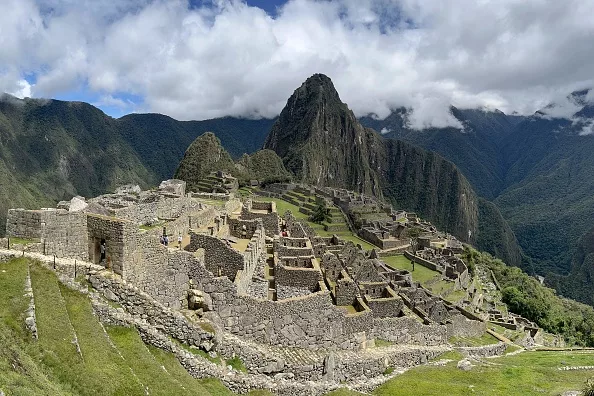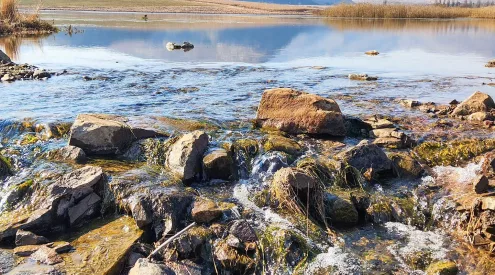Nestled within a breathtaking landscape at the juncture of the Peruvian Andes and the Amazon Basin, lies the Historic Sanctuary of Machu Picchu, a masterpiece of artistic, architectural, and land utilization achievements, standing as the most significant tangible heritage of the Inca civilization.

General view of the ancient Inca ruins of Machu Picchu in the Urubamba valley, seventy-two kilometres from the Andes city of Cusco, on February 15, 2023, open for the first time after they were closed to the public for security reasons on January 21, after protesters blocked the railways during protests against the government of President Dina Boluarte that have shaken the Andean country since December 7, 2022. (Photo by Carolina Paucar / AFP) (Photo by CAROLINA PAUCAR/AFP via Getty Images)
This exceptional mixed World Heritage site encompasses 32,592 hectares of rugged mountains, peaks, and valleys, centred around the awe-inspiring archaeological marvel known as “La Ciudadela” (the Citadel), perched over 2 400 meters above sea level. Originally constructed in the 15th century, Machu Picchu was abandoned after the Spanish conquest of the Inca Empire, and it remained hidden from the world until its discovery in 1911.
Comprising approximately 200 structures, this extraordinary site served as a religious, ceremonial, astronomical, and agricultural centre, carefully arranged along a steep ridge and interconnected by stone terraces. The city was thoughtfully divided into lower and upper sections, demarcating the agricultural and residential areas, with a grand square between them. Despite extensive research, many mysteries surrounding Machu Picchu persist, including its exact role in the Incas’ advanced understanding of astronomy and the domestication of wild plant species.
Machu Picchu’s massive yet refined architecture harmoniously blends with the stunning natural environment, to which it is intricately linked. A network of subsidiary centres, roads, trails, irrigation canals, and agricultural terraces attests to centuries of human utilization. The challenging topography has resulted in a mosaic of utilized spaces and diverse natural habitats. These eastern slopes of the tropical Andes boast a remarkable gradient, encompassing high-altitude “Puna” grasslands, Polylepis thickets, montane cloud forests, and tropical lowland forests, all of which harbour rich biodiversity and significant endemic species. Though the site may be relatively small, it plays a crucial role in conserving a diverse array of flora and fauna, including rare and endemic species.
The Historic Sanctuary of Machu Picchu is an integral part of Peru’s national protected areas system and is safeguarded by a comprehensive legal framework, addressing both its cultural and natural significance. The sanctuary’s boundaries are well-defined, and it is surrounded by a buffer zone larger than the protected area itself.
In 1999, the Management Unit of the Historic Sanctuary of Machu Picchu (UGM) was established to implement the strategies outlined in the Master Plans, which regularly guide the site’s management. The UGM, reactivated in 2011, consists of representatives from the Ministries of Culture, Environment, and Foreign Trade and Tourism, along with the Regional Government of Cusco and the local municipality of Machu Picchu. This collaborative platform is essential for managing a site that forms an integral part of Peru’s identity and serves as a prominent domestic and international tourist destination.
Despite the robust legislative and management framework, there are challenges related to inter-institutional governance and the effectiveness of protection measures. Harmonizing dispersed legislation and involving various ministries and governmental levels, from local to national, remains complex, particularly when sharing tourism revenues. Tourism brings economic benefits but also poses cultural and ecological challenges, as the increasing number of visitors requires careful regulation and efforts to minimize impacts. Reinvesting a substantial portion of tourism revenues into planning and management would be beneficial. Transportation and infrastructure development, as well as ensuring the well-being of both tourists and new residents attracted by tourism, demand high-quality, sustainable, and long-term solutions.
Since its inscription as a World Heritage site, concerns have been raised about ecosystem degradation resulting from logging, firewood and plant collection for commercial purposes, inadequate waste management, poaching, and agricultural encroachment due to unclear land tenure arrangements. Additionally, introduced species and water pollution from urban waste and agrochemicals in the Urubamba River, along with broader regional development pressures, further compound the risks. The site’s location in high-altitude terrain with extreme weather conditions makes it susceptible to natural disasters, requiring continuous efforts to adhere to protected areas legislation and prevent further degradation. Nevertheless, there is significant potential for restoring degraded areas and preserving this extraordinary sanctuary for generations to come.
Follow us on social media for more travel news, inspiration, and guides. You can also tag us to be featured.
TikTok | Instagram | Facebook | Twitter
ALSO READ: The new 7 Wonders of the world

















